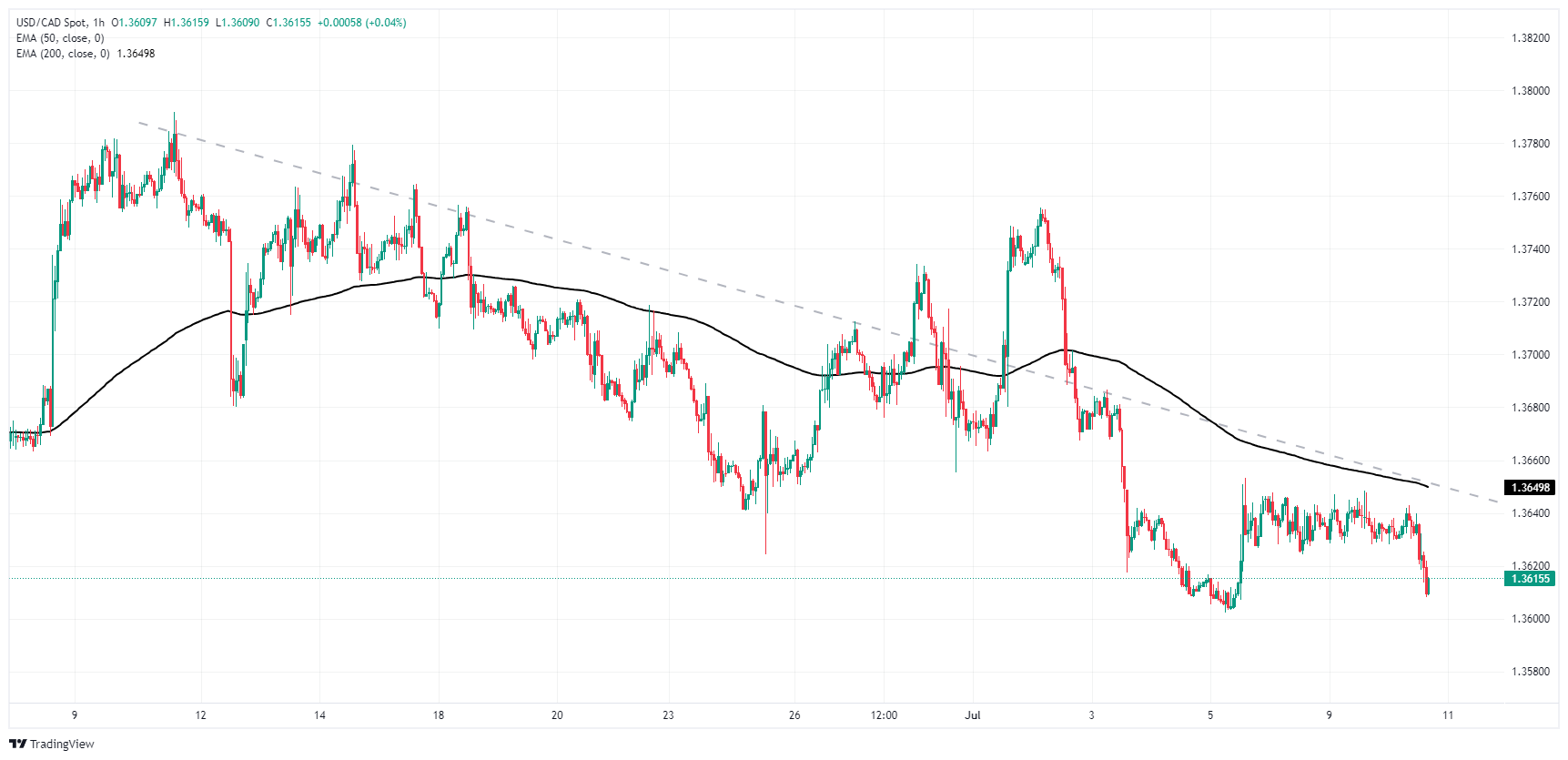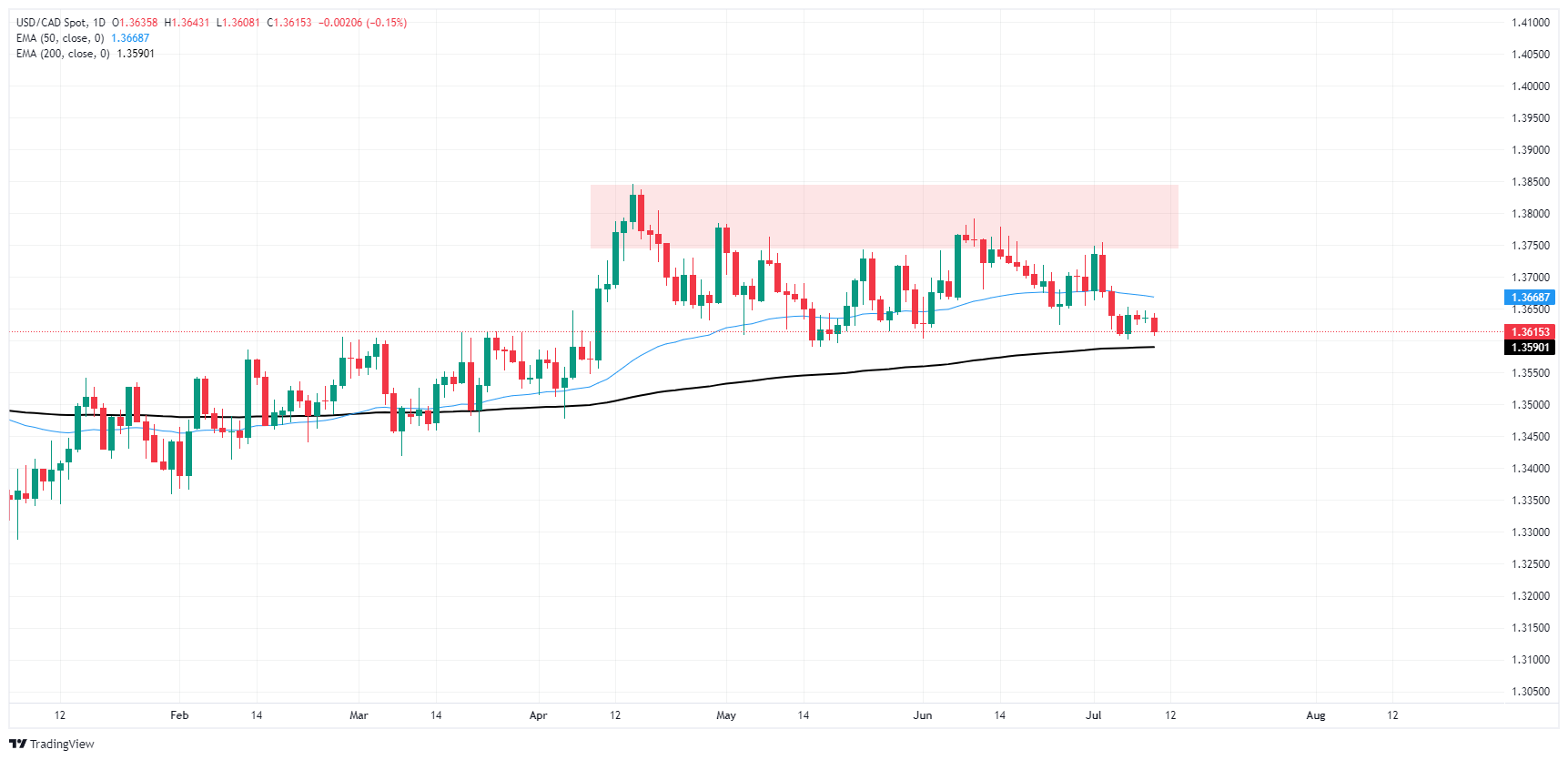Canadian Dollar eases higher as markets look elsewhere
- The Canadian Dollar found thin gains on Wednesday.
- Canada market flows remain thin, and no meaningful CAD data is on the docket.
- US inflation figures due later in the week remain the key risk event.
The Canadian Dollar (CAD) edged higher on Wednesday, bolstered more by a general uptick in broad-market risk appetite and a bullish reversal in Crude Oil than anything related to a shift in CAD sentiment. Federal Reserve (Fed) Chairman Jerome Powell made his second of two appearances in as many days before US Congressional financial committees, delivering the Fed’s latest Semi-Annual Monetary Policy Report.
Canada has had a quiet week on the economic calendar, and the trend of data-less CAD trading is set to continue until next week’s Canadian inflation print set for next Tuesday, with Canadian Retail Sales far-flung to next Friday. In the meantime, a key print in US inflation figures will dominate market flows this week, with US Consumer Price Index (CPI) inflation and Producer Price Index (PPI) wholesale inflation slated for this Thursday and Friday, respectively.
Daily digest market movers: Canadian Dollar softly bolstered by step-up in market risk appetite
- CAD traders are settled in for the long wait for Canadian CPI inflation numbers due next week.
- Data-light CAD finds support from rising Crude Oil bids on Wednesday plus a general improvement in investor sentiment during the midweek market session.
- Fed Chair Powell stuck close to his familiar script during his two-day testimony before US Congressional committees while delivering the Fed’s latest Monetary Policy Report.
- Fed Chair Powell noted that while the Fed still wants more confidence that inflation will ease to the US central bank’s 2% annual inflation target, that doesn’t necessarily mean the Fed will wait until inflation has hit 2% to begin easing rates.
- However, Fed Chair Powell warned that despite easing inflation and a softening labor market, housing and shelter inflation remains a concern.
- According to the CME’s FedWatch Tool, rate traders are still leaning fully into a September rate cut, with markets pricing in at least a 25 basis point trim to the fed funds rate on September 18.
- Jerome Powell Speech: Chairman testifies before House Financial Services Committee
Canadian Dollar PRICE Today
The table below shows the percentage change of Canadian Dollar (CAD) against listed major currencies today. Canadian Dollar was the strongest against the New Zealand Dollar.
| USD | EUR | GBP | JPY | CAD | AUD | NZD | CHF | |
|---|---|---|---|---|---|---|---|---|
| USD | -0.12% | -0.47% | 0.21% | -0.17% | -0.09% | 0.71% | 0.17% | |
| EUR | 0.12% | -0.33% | 0.35% | -0.04% | 0.01% | 0.81% | 0.28% | |
| GBP | 0.47% | 0.33% | 0.71% | 0.31% | 0.34% | 1.15% | 0.60% | |
| JPY | -0.21% | -0.35% | -0.71% | -0.37% | -0.32% | 0.45% | -0.08% | |
| CAD | 0.17% | 0.04% | -0.31% | 0.37% | 0.07% | 0.87% | 0.31% | |
| AUD | 0.09% | -0.01% | -0.34% | 0.32% | -0.07% | 0.79% | 0.24% | |
| NZD | -0.71% | -0.81% | -1.15% | -0.45% | -0.87% | -0.79% | -0.54% | |
| CHF | -0.17% | -0.28% | -0.60% | 0.08% | -0.31% | -0.24% | 0.54% |
The heat map shows percentage changes of major currencies against each other. The base currency is picked from the left column, while the quote currency is picked from the top row. For example, if you pick the Canadian Dollar from the left column and move along the horizontal line to the US Dollar, the percentage change displayed in the box will represent CAD (base)/USD (quote).
Technical analysis: Canadian Dollar dragged slightly higher by broader market forces
The Canadian Dollar (CAD) traded a step higher than the US Dollar (USD) on Wednesday, up a thin sixth of a percent against the Greenback. The CAD softened around three-tenths of one percent against the bullish Pound Sterling (GBP), and the Canadian Dollar benefits from broad-market selling pressure forcing the New Zealand Dollar (NZD) lower. The CAD is up nearly nine-tenths of one percent against the NZD on Wednesday.
USD/CAD continues to churn just above 1.3600, but near-term short pressure has pushed the USD lower against the CAD, sending the pair down from intraday consolidation near 1.3640. Daily candlesticks continue to drift down toward the 200-day Exponential Moving Average (EMA) at 1.3590 as bids get squeezed between the long-term moving average and a supply zone priced in above 1.3750.
USD/CAD hourly chart
USD/CAD daily chart
Canadian Dollar FAQs
The key factors driving the Canadian Dollar (CAD) are the level of interest rates set by the Bank of Canada (BoC), the price of Oil, Canada’s largest export, the health of its economy, inflation and the Trade Balance, which is the difference between the value of Canada’s exports versus its imports. Other factors include market sentiment – whether investors are taking on more risky assets (risk-on) or seeking safe-havens (risk-off) – with risk-on being CAD-positive. As its largest trading partner, the health of the US economy is also a key factor influencing the Canadian Dollar.
The Bank of Canada (BoC) has a significant influence on the Canadian Dollar by setting the level of interest rates that banks can lend to one another. This influences the level of interest rates for everyone. The main goal of the BoC is to maintain inflation at 1-3% by adjusting interest rates up or down. Relatively higher interest rates tend to be positive for the CAD. The Bank of Canada can also use quantitative easing and tightening to influence credit conditions, with the former CAD-negative and the latter CAD-positive.
The price of Oil is a key factor impacting the value of the Canadian Dollar. Petroleum is Canada’s biggest export, so Oil price tends to have an immediate impact on the CAD value. Generally, if Oil price rises CAD also goes up, as aggregate demand for the currency increases. The opposite is the case if the price of Oil falls. Higher Oil prices also tend to result in a greater likelihood of a positive Trade Balance, which is also supportive of the CAD.
While inflation had always traditionally been thought of as a negative factor for a currency since it lowers the value of money, the opposite has actually been the case in modern times with the relaxation of cross-border capital controls. Higher inflation tends to lead central banks to put up interest rates which attracts more capital inflows from global investors seeking a lucrative place to keep their money. This increases demand for the local currency, which in Canada’s case is the Canadian Dollar.
Macroeconomic data releases gauge the health of the economy and can have an impact on the Canadian Dollar. Indicators such as GDP, Manufacturing and Services PMIs, employment, and consumer sentiment surveys can all influence the direction of the CAD. A strong economy is good for the Canadian Dollar. Not only does it attract more foreign investment but it may encourage the Bank of Canada to put up interest rates, leading to a stronger currency. If economic data is weak, however, the CAD is likely to fall.
